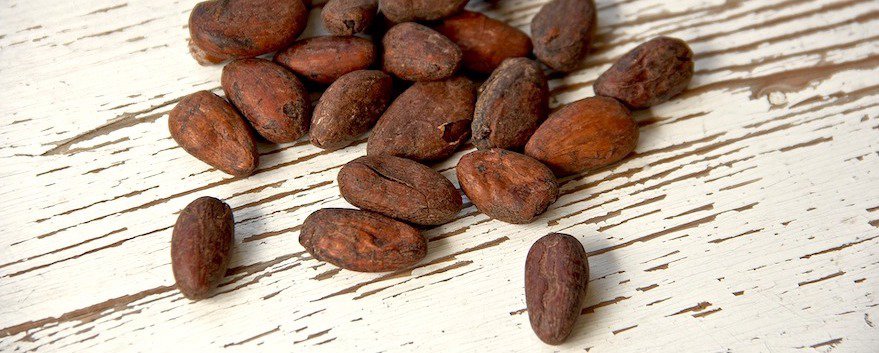What is Theobromine?
The Alkaloid of Chocolate
Originating from America, cocoa, the main ingredient in chocolate, contains a multitude of molecules with significant nutritional potential, as well as numerous health benefits.
Cocoa is very rich in magnesium, triglycerides, and antioxidants, but that’s not all. It contains another molecule of interest for health: theobromine.
Discovered in 1878 in cocoa seeds, theobromine is an alkaloid, a naturally occurring organic substance belonging to the methylxanthines family.
Its name, “theobromine” comes from theobroma, the generic name of the cocoa tree, composed of the Greek roots theo (“god”) and broma (“food”), meaning “food of the gods”. The suffix “-ine” was added, as is common for alkaloids.

How does theobromine work on our body?
Theobromine is a molecule very similar to caffeine. It also has an energizing and stimulating effect, but its action is longer and softer.
Just like caffeine, it works by blocking adenosine receptors, a substance that inhibits arousal, causing an increase in the secretion of epinephrine (a “stimulant” hormone related to adrenaline).
No worries, chocolate can be safely consumed, within reason, and if it is a quality chocolate with clear traceability!
Indeed, the dosage of theobromine is sufficiently low in chocolate to have no harmful effect on the body. Doses over 1000 mg have been safely used in clinical trials without adverse effects, although they can cause slight gastric discomfort.

In which foods can it be found?
Theobromine is found in greater amounts in cocoa, but not only. It is also present at lower doses in coffee beans, in the leaves of mate, in guarana, in kola nut, and also in the tea we drink.
Its concentration is quite variable:
- Cocoa bean: 1100 – 4300 mg per 100 g
- Cocoa powder: 530 – 2600 mg per 100 g
- Mate leaf: 450 – 900 mg per 100 g
- Guarana: 20 – 60 mg per 100 g
- Dark chocolate: 450 – 1600 mg per 100 g

All chocolate products contain theobromine, but dark chocolate has higher amounts since it is not diluted with ingredients such as milk and cream.
Milk chocolate contains less due to the addition of sugar and fats. This applies to all other nutrients present in cocoa!
What are the benefits of theobromine?
What science says
Theobromine can have many effects on the human body, particularly:
- A feeling of well-being: this substance is one of the causes of chocolate’s positive effects on mood. Theobromine, on the central nervous system, would stimulate the production of endorphins, a molecule (neurotransmitter) inducing well-being.
- In medicine, it is used as a cardiac stimulant, diuretic, and vasodilator (it dilates blood vessels leading to a decrease in blood pressure).
Boost effect on the brain

By causing the secretion of epinephrine (a stimulating hormone that allows the body to respond to stress), theobromine induces nerve activity and an increase in heart rate keeping our body alert.
In a clinical study of a wide range of oral doses of theobromine (250, 500, and 1000 mg) among 80 healthy participants, theobromine showed differential effects depending on the dose.
At 250 mg, it showed positive effects on mood, which became negative at higher doses. It also increased heart rate depending on the dose.
These results suggest that theobromine at normal intake levels, as found in a standard 40 g bar of dark chocolate, can contribute to the positive effects of chocolate on our mood.

Cardiovascular protection and effect on cholesterol
Several clinical trials suggest a beneficial effect on the cardiovascular system. A scientific study on the consumption of 850 mg/day of theobromine for 4 weeks suggests an increase in HDL cholesterol (the “good cholesterol”), reducing the risk of cardiovascular diseases.
A meta-analysis appears to show a correlation between higher consumption of dark chocolate and the reduction of cardiovascular diseases.
Effect on cough
Scientific data demonstrates that theobromine may have antitussive properties, meaning it could relieve cough.
Theobromine would work by inhibiting the activity of the vagus nerve which innervates some constrictor muscles of the pharynx and larynx, thus reducing the frequency of the reflex that causes coughing.
Keep your chocolate bars away from your four-legged friend!

Theobromine present in cocoa and chocolate-based products can be toxic to certain pets such as dogs and cats.
While the human body can metabolize this substance, pets accumulate it for a long time in the blood causing cardiac arrhythmias and convulsions that can lead to death.
The first signs of poisoning are nausea, vomiting and diarrhea.
Sources and scientific studies
Franco R, Oñatibia-Astibia A, Martínez-Pinilla E. Health benefits of methylxanthines in cacao and chocolate. Nutrients. 2013;5(10):4159‐4173. Published 2013 Oct 18. doi:10.3390/nu5104159
Theobromine, IARC Monographs, vol. 51, 1991, p. 421 – 441
Baggott, M.J., Childs, E., Hart, A.B. et al. Psychopharmacology of theobromine in healthy volunteers. Psychopharmacology 228, 109–118 (2013). https://doi.org/10.1007/s00213-013-3021-0
Neufingerl N. et al, « Effect of cocoa and theobromine consumption on serum HDL-cholesterol concentrations: a randomized controlled trial », American Society for Nutrition, 2013
H Franco O. et al., « Chocolate consumption and cardiometabolic disorders: systematic review and meta-analysis », BMJ, 343 : d4488, 2011
Usmani, O. S. et al., « Theobromine inhibits sensory nerve activation and cough », Faseb Journal Vol 17, doi:10.1096/fj.04-1990fje, 2004
Kovalkovicova N., « Some food toxic for pets », Interdisciplinary Toxicology, (2009), Vol.



